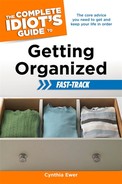Controlling Workplace Clutter
Workplace clutter comes in many forms. Documents are dumped on the desk multiple times a day. Email messages surge into the inbox minute by minute. Handouts and presentation tools pile up in corners of the office, while briefcases fill up with swag from conventions and clients.
Tackle workplace clutter with the same tools you use at home. Clear it out regularly, and put safeguards in place to keep it from piling up around your office.
On the Desk
Daily clutter control can keep the level of chaos in an office down to a dull roar. Before leaving each day, clear spaces, file papers, and return office supplies to their proper places.
Once a week, hold a brief STOP clutter session to clear a single drawer, shelf, or file section of clutter. Sort, toss, organize, and put away items to create clutter-free spaces. Over time, your efforts will reduce existing piles and keep new ones from forming.
Don’t go overboard on desktop equipment. Keeping more supplies on hand than you can use in the short term eats into valuable desktop space and clutters your work area. Leave the extras in the supply closet or desk drawers to keep desk areas lean, mean, and productive.
Subdivide office drawers with drawer dividers or organizers created for flatware and cutlery. You’ll save time sifting through small items to locate a binder clip or staple remover.
Resist the urge to print. While making paper copies can lead to a feeling of security, the practice can also lead to a lot of clutter. Use the printer sparingly to keep from drowning in unnecessary printed items.
After each project is completed, clear the decks. Toss draft copies of documents and tuck away related computer files in an appropriate location. Remove research materials from the desk to create a clean slate for the next project.
| SPEEDY SOLUTION |
Don’t bother keeping hard copies of product manuals and software guides; these reference works are easily available online if you need them.
In Your Space
To cut office clutter, round up the usual suspects: those items that make the transition to clutter right away and don’t belong in an organized space. Prime targets include promotional giveaways or convention freebies, superseded drafts of documents or presentations, dried-out pens, and outdated technology items such as floppy disks or low-density thumb drives.
Changing work patterns, such as moving to paperless systems, can lead to a surfeit of unused supplies. Get rid of any office supplies that you haven’t used in a year, taking particular aim at outdated technology. If file transfers are now handled online, there’s no need to hold on to multiple spindles of burnable CD discs.
Managing Data Clutter
Virtual workspaces, like physical ones, can become cluttered with unneeded items, making the good stuff hard to find. Keep your computer’s desktop as spare and organized as you keep the desk where you sit. You’ll focus on the day’s work more easily if you reduce the number of distracting desktop icons and store project files in document folders.
For most people, email is the primary source of data clutter at the office. To keep junk mail from clogging your inbox, activate spam filters in your mail client to send Nigerian check-cashing scams straight to the recycling bin.
It can be a bit trickier to cut down on “friend spam”: those waves of forwarded jokes and links to funny videos that pile up in the inbox. Nicely asking the principal offenders to remove you from their distribution list sometimes works; another way to cope is to send all mail from these sources directly to a subfolder, out of your way.
Just as you clean your desk area, tidy up computer files at the completion of each project. Delete draft versions and consolidate computer files in a single folder. Empty the recycling bin (or trashcan, for Mac users) regularly to purge the hard drive of discarded files.
